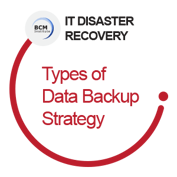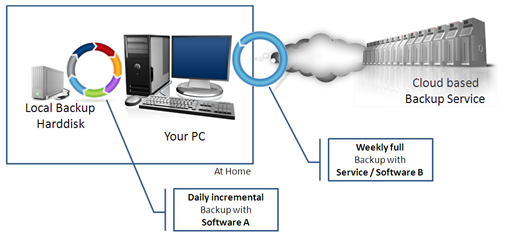Overview of Data Backup
The Disaster Recovery Strategy phase is to identify the means to restore IT operations efficiently and effectively following a service disruption caused by any residual risks identified during the Risk Analysis and Review phase.
A good recovery strategy must address all the potential impacts identified during the BIA process and can be integrated into the overall IT system architecture during its design and implementation phases.
The key considerations for developing a good strategy are cost, allowable outage time, security and ability to integrate with the enterprise-wide DR Plans. A recovery strategy can be achieved with one or a combination of multiple approaches that complement each other to provide the overall recovery capability to address the full spectrum of identified risks. In addition, the most appropriate recovery approach is one that can be implemented on the IT system and meet the system’s operational requirements.
Some of the recovery approaches available include commercial contracts with cold, warm, or hot site vendors, mobile sites, mirrored sites, reciprocal agreements with internal or external organizations, and service level agreements with the equipment vendors. IT technologies like Redundant Arrays of Independent Disks (RAID), automatic fail-over, Uninterrupted Power Supplies (UPS), and mirrored systems are also viable recovery approaches that can be carefully thought about. In the subsequent sections, we will drive into detail the various recovery approaches that you can use to develop your DR strategy.
Planning DR Strategy
The primary aim of DR Planning is to efficiently respond to and recover from a disaster event. Thus, DR Planning focuses on minimizing the impact of the disasters facing an organization. The typical strategies that are applied are as follows:
Avoid (or Prevent)
Implement baseline measures to ensure the security and reliability of activities and systems upon which the existence of an organization is highly dependent. Acquire or develop tools and techniques to eliminate bugs, configuration errors, and hardware failure.
Reduce (or Mitigate)
Implement measures to minimize the impact of unavoidable disasters or risks.
Respond/Recover or Anticipate
Identify the procedures to respond to and recover from disasters. This is achieved through the prediction of scenarios that are likely to result in a disaster, their likelihood of occurrence and their impact. Information for the formation of scenarios is acquired from experience, the configuration of the system deployed in the organization, problems logs, and audit reports
Backup Strategies
The critical success factor for a successful implementation of DR strategy is your ability to recover vital records, such as your critical business data and application programs, not just your hardware, software and staff alone.
The mechanism to ensure continuity and availability of data and applications is to have a fault-tolerant set of backup and recovery processes to complement the complete DR strategy.

Backup Strategies
In general, all IT personnel today agree on all the following facts:
- Data, regardless of business data, system operational parameters, system guides, application programs, and so on must be backed up regularly.
- IT policies must be in place to specify the frequency of backups (e.g., daily or weekly, incremental or full), based on data criticality and the frequency that new information is introduced.
- Data backup policies shall designate the location of stored data, file-naming conventions, tape rotation frequency, and method of transporting data offsite.
- Data may be backed up on a magnetic disk, tape, or optical disks (such as compact disks [CD]). The specific method and media chosen for backup storage shall be based on system, data availability and integrity requirements. Examples of these methods are electronic vaulting, mirrored disks using direct access storage devices [DASD] or RAID, and floppy disks.
However, IT people need to understand the details of the selection criteria for adopting the most suitable backup and recovery process for the organization, so as to ensure the availability of critical digital assets during any disaster. In this section, a summary of the various backup and recovery options will be discussed.
Reference
Goh, M. H. (2016). A Manager's Guide to Implementing Your IT Disaster Recovery Plan. Business Continuity Management Specialist Series (2nd ed.). Singapore: GMH Pte Ltd.
Extracted from "Chapter 8: DR Strategy: Data Backup"
More Information About IT DR Blended Learning
![Email to Sales Team [BCM Institute]](https://no-cache.hubspot.com/cta/default/3893111/3c53daeb-2836-4843-b0e0-645baee2ab9e.png) To know more about our blended learning program and when the next course is scheduled, feel free to click the icon on right to contact our course consultant colleagues
To know more about our blended learning program and when the next course is scheduled, feel free to click the icon on right to contact our course consultant colleagues
They are the BL-DR-3 Blended Learning DR-300 IT Disaster Recovery Implementer and the BL-DR-5 Blended Learning DR-5000 IT Disaster Recovery Expert Implementer.
 |
Please feel free to send us a note if you have any of these questions to sales.ap@bcm-institute.org |
 |




![Register [BL-DR-3]*](https://no-cache.hubspot.com/cta/default/3893111/15b32c57-3105-4c0c-96fc-92ce68950f81.png)




